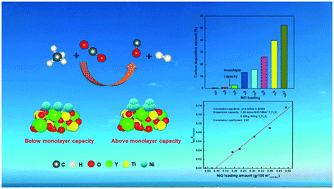NiO supported on Y2Ti2O7 pyrochlore for CO2 reforming of CH4: insight into the monolayer dispersion threshold effect on coking resistance
Abstract
In this study, with the aim of unravelling the interaction between Ni/NiO and its Y2Ti2O7 support, and eventually fabricating highly efficient catalysts for the DRM reaction, NiO/Y2Ti2O7 catalysts with varied NiO loadings were designed based on monolayer dispersion theory. With X-ray diffraction and X-ray photoelectron spectroscopy extrapolation methods, it is revealed that the monolayer dispersion capacity of NiO on the Y2Ti2O7 support is 1.20 mmol NiO/100 m2 Y2Ti2O7, equal to 2.4 wt% loading. All the catalysts exhibit similar and high DRM reaction performance when the NiO loading is above 1%. TGA-DSC and Raman results indicate that the samples with NiO loading around the monolayer dispersion capacity possess optimal anti-coking ability. On these samples, NiO species is present mainly in the monolayer or sub-monolayer state, which interacts strongly with the support through electron donation from Y3+ and Ti4+ in the support to the Ni2+ cations. As a result, active metallic Ni with a large surface area can be obtained and stabilized. However, further increasing the NiO loading leads to a weaker Ni/NiO–Y2Ti2O7 interaction, and the formation of larger Ni grains as a result of coking. Therefore, the samples with NiO loading around the monolayer dispersion capacity possess the best ability to activate the reactants and have considerable amounts of active Ni surface area, thus displaying optimal DRM reaction performance. In conclusion, an evident monolayer dispersion threshold effect is observed on coking resistance for NiO/Y2Ti2O7. It is proposed that the best NiO/Y2Ti2O7 catalyst for the DRM reaction can be fabricated by loading exactly the monolayer dispersion amount of NiO onto the Y2Ti2O7 support.



 Please wait while we load your content...
Please wait while we load your content...